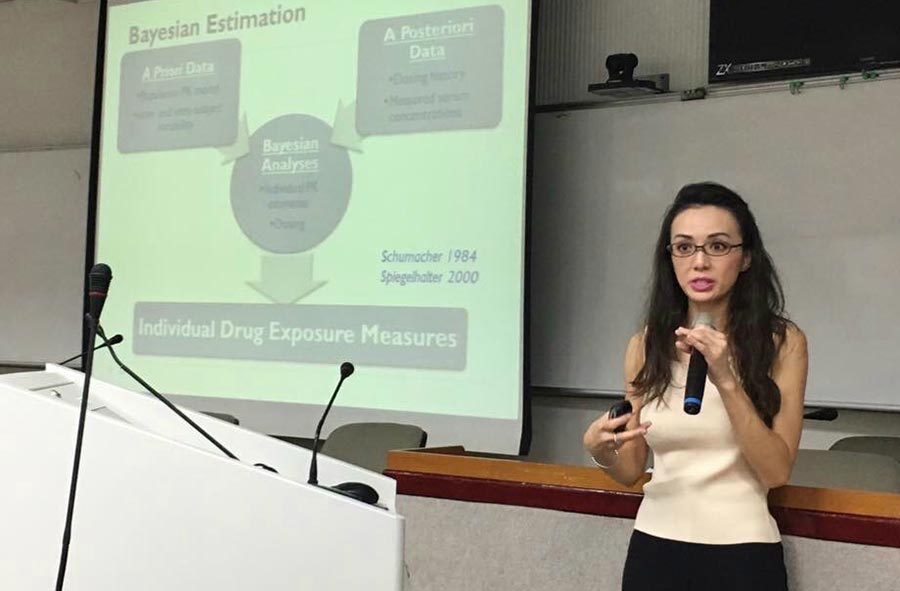By:
- Heather Buschman
Published Date
By:
- Heather Buschman
Share This:
UC San Diego Pharmacist’s Work Helps Save Lives Across the Globe

Jennifer Le, professor in the Skaggs School of Pharmacy and Pharmaceutical Sciences at UC San Diego.
Jennifer Le thought of her many distant colleagues at the Hospital for Tropical Diseases in Vietnam when she read a news article about one of their patients—a 42-year-old Scottish pilot who had recovered from COVID-19 after two-and-a-half months in a medically induced coma.
“But I was surprised when I got a post on social media, thanking me,” Le said. “They said the vancomycin therapeutic monitoring program has been instrumental in helping critically ill patients during the COVID-19 pandemic.”
Le is a faculty member at Skaggs School of Pharmacy and Pharmaceutical Sciences at UC San Diego. She’s also a national leader in developing therapeutic drug monitoring programs for vancomycin—a highly toxic antibiotic that must be carefully managed and personalized for each individual patient so that it works, but doesn’t damage the patient’s kidneys in the process.
For more than a decade, Le has collaborated with the Hospital for Tropical Diseases, Vietnam’s main hospital, to help implement therapeutic drug monitoring programs for vancomycin and other powerful antibiotics. Antibiotic resistance is a huge issue in Vietnam, she says—even resistance to what clinicians in the U.S. call the “last-resort antibiotics.” At the same time, the selection of antibiotics is limited due to cost.
According to the news article, the Scottish pilot, or “Patient 91,” as he was known as, was the sickest patient with COVID-19 that doctors had treated in Vietnam, a country that has had only a few hundred cases and no deaths. His case was so unusual that it was followed closely by the country’s media outlets.
Vancomycin monitoring programs typically work like this: A physician orders vancomycin for a patient. Then pharmacists like Le calculate the best dose and monitor the response. They check drug levels in the blood and kidney function. Then they use an approach called clinical pharmacokinetics to determine if the patient is getting enough vancomycin or not enough, and how quickly or slowly the body clears the antibiotic and, of course, whether or not it’s working.
Before she helped them with vancomycin dosing, Le found that many clinicians in Vietnam were giving their patients too little using a standard dose. More recently, their patients have been faring better. “Just a few days of training made a world of difference,” she said. More recently, she has co-authored national vancomycin management guidelines for health care providers in the U.S.

Jennifer Le teachescourses in pharmacokinetics and therapeutic drug monitoring to third-year students in the Skaggs School of Pharmacy.
Now, vancomycin monitoring programs are more important than ever. It may seem counterintuitive since antibiotics work only against bacteria, but many patients with COVID-19, a viral infection, may be prescribed vancomycin due to the critical nature of their illness.
“What often happens is a patient who spends a long time in the hospital may develop blood or lung infections with antibiotic-resistant bacteria known as MRSA—that’s short for methicillin-resistant Staphylococcus aureus, sometimes also called a ‘superbug’—and the usual treatment to start, especially in an under-resourced country, is vancomycin,” Le explained.
Staph bacteria commonly live on our skin and nasal passages without problem. But when a person is severely weakened by something like COVID-19 and a long hospitalization, those quiet, resident bacteria can rise up and find their way into the blood and down the lungs without much of a challenge by the immune system. The result is often blood infection (sepsis) or a second type of pneumonia.
“There are no studies that formally evaluate the two infections concurrently, but MRSA may be a double hit for patients with COVID-19,” Le said. “So, the better we can manage the infection, the better their chances of recovery.”
Le’s role in patient care is becoming more common. Pharmacists are increasingly called upon to work with other health care professionals in managing acute and chronic illnesses, adjusting drug doses, counseling patients, identifying drug interactions, and monitoring and managing therapeutic outcomes.
At the Skaggs School of Pharmacy—a U.S. News & World Report-ranked top 20 pharmacy school and first in the nation for licensure exam first-time pass rates—Le also teaches courses in pharmacokinetics and therapeutic drug monitoring to third-year students.
“I’m a math person, so I’ve always loved pharmacokinetics,” she said. “This approach goes hand-in-hand with infectious diseases because it’s a dynamic situation—every type of bacteria and every patient are different. While vancomycin is a 60-year-old medication, bacteria evolve quickly, and the way we use it needs to constantly change to keep up.”
Share This:
Stay in the Know
Keep up with all the latest from UC San Diego. Subscribe to the newsletter today.



